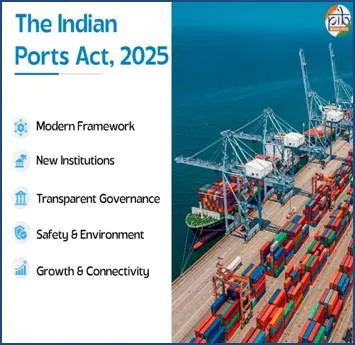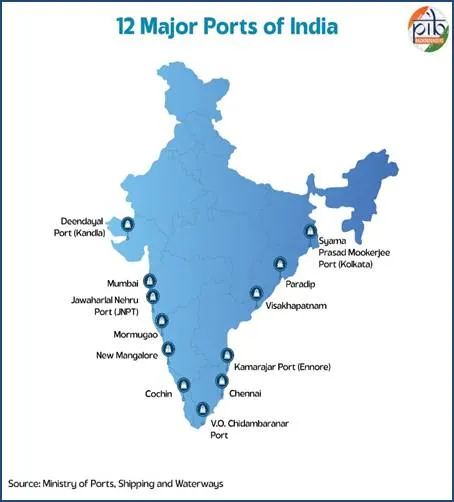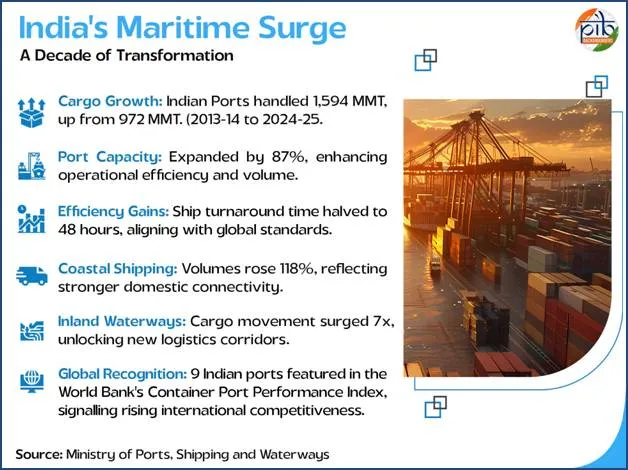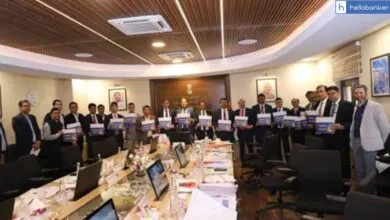The Indian Ports Act 2025 [PDF]
![The Indian Ports Act 2025 [PDF]](https://hellobanker.in/wp-content/uploads/2025/09/The-Indian-Ports-Act-2025-PDF-780x470.webp)
The Indian Ports Act, 2025 replaces the old Indian Ports Act, 1908 with new and modern rules. The Act sets up the Maritime State Development Council (MSDC) as a statutory body. This council will help the Centre and coastal States work together. The law also makes it compulsory for ports to follow Global Green Norms and maintain disaster readiness. It simplifies port procedures and brings in digital systems to improve the Ease of Doing Business (EODB).

Ports have always played a silent but strong role in India’s economy. As India grows, the importance of ports has become even greater. Ports are not only for trade and logistics, but also support industries, create jobs, and help in urban development.
The Indian Ports Act, 2025, passed by Parliament in August 2025, is a big reform in maritime governance. It replaces a century-old law with a modern framework for today’s economy. The Act reflects the Government’s vision of making ports engines of growth, jobs, and connectivity. By bringing all port laws together and giving States more power, the Act promotes cooperative federalism and balanced development along India’s coast. It seeks to use the full potential of India’s 7,500 km coastline, improve port administration, and follow global maritime standards. This Act is a key step in making India a global maritime leader.
Ports are vital for India’s development. They support trade, industry, and regional connectivity. Ports act as gateways for imports and exports and are central to supply chains. Around 95% of India’s EXIM cargo by volume and 70% by value moves through ports. India has 12 major ports and 200+ non-major ports. Major ports are under the Ministry of Shipping, while non-major ports are managed by State Maritime Boards or State Governments. All major ports are active, but only about 65 non-major ports handle cargo. The rest mostly serve fishing boats and small ferries.

In the last decade, India’s port sector has changed a lot. Ports have increased their capacity and improved performance to match global standards. This has improved domestic trade routes and also raised India’s position in global trade. The growth of ports shows how important they are for India’s future as a maritime power.
The Indian Ports Act, 2025 replaces outdated colonial rules with a modern system. It promotes integrated development, strengthens Centre-State coordination, and brings India’s port governance closer to global practices. It also boosts India’s strategic maritime strength.

This Act brings a modern framework for better governance, transparency, and sustainability in ports. It gives more powers to statutory bodies, makes dispute resolution easier, regulates tariffs, and ensures strong environmental protection. These measures align India with the world’s best maritime standards.
| Key Anchors of the Indian Ports Act, 2025 |
| PORT OFFICERS |
| The Act designates the conservator – appointed by the government – as the port officer, with authority over other officers. The conservator retains powers over vessel movement within port limits and fee recovery, and adds new responsibilities for disease control, damage assessment, and penalty adjudication. |
| STATUTORY BODIES |
| State Maritime Boards: The Act formally recognizes State Maritime Boards established by coastal states and empowers them to manage non-major ports. These Boards will oversee port planning, infrastructure development, licensing, tariff regulation, and enforcement of safety, security, and environmental compliances.Maritime State Development Council: The Act grants statutory status to the Maritime State Development Council. The Council will guide data collection and dissemination and transparency across ports, and advise the central government on national planning, legislative reforms, port efficiency, and connectivity. |
| DISPUTE RESOLUTION MECHANISM |
| State governments must set up Dispute Resolution Committees (DRCs) to resolve conflicts among non-major ports, concessionaires, users, and service providers. Appeals go to the High Court, not civil courts. The Boards may also allow arbitration or other alternative dispute resolution methods. This will benefit the speedy dispute resolution. |
| TARIFF REGULATION |
| Tariffs at major ports will be determined either by the Board of the Major Port Authority or by the Board of Directors if the port operates as a registered company. For non-major ports, tariff-setting authority rests with the State Maritime Board or its designated concessionaire. Further, the Indian Port Act 2025 requires tariffs and charges to be published electronically for transparency. |
| SAFETY AND SUSTAINABILITY |
| The Act upholds penalties for safety violations like damaging buoys or mishandling combustibles on board. It strengthens environmental protections by aligning with global conventions (MARPOL, Ballast Water Management) and introducing new mandates for pollution control and disaster readiness. Central government will conduct audits to ensure compliance with waste handling and emergency response plans. |
These measures will be transforming India’s maritime sector by streamlining legal frameworks, promoting coordinated port development, and enhancing business efficiency. Institutional reforms will empower states and foster strategic planning through dedicated bodies like State Maritime Boards and the Maritime State Development Council. Digitalisation plays a key role in improving port operations, with initiatives like the Maritime Single Window and Advanced Vessel Traffic Systems helping to boost efficiency, ease congestion, and lower operational costs.
The Transformative Impact of the Indian Port Act, 2025
The Indian Ports Act, 2025 emerges as a timely and transformative step toward modernizing and unifying port laws, boost development, and make business easier. It sets up strong governance bodies at the state and national levels, ensures safety and sustainability at ports, and aligns India with global standards. It also introduces systems to resolve disputes efficiently.
| Consolidation & Development |
| Unifies and updates laws related to ports across India. Promotes integrated and strategic development of ports nationwide. Enhances ease of doing business in the maritime sector. Ensures optimal use of India’s extensive coastline. |
| Institutional Strengthening |
| Establishes and empowers State Maritime Boards to manage non-major ports effectively. Sets up the Maritime State Development Council to guide structured growth and coordination across states. |
| Safety, Sustainability & Compliance |
| Provides frameworks for managing: Pollution control Disaster response and emergency preparedness Port security and safety Navigation systems and port-related data Ensures India meets its commitments under relevant international maritime agreements. |
| Environmental Conservation |
| Introduces measures to protect and conserve port ecosystems and infrastructure. |
| Dispute Resolution |
| Creates adjudicatory mechanisms for resolving port-related disputes efficiently and transparently. |
